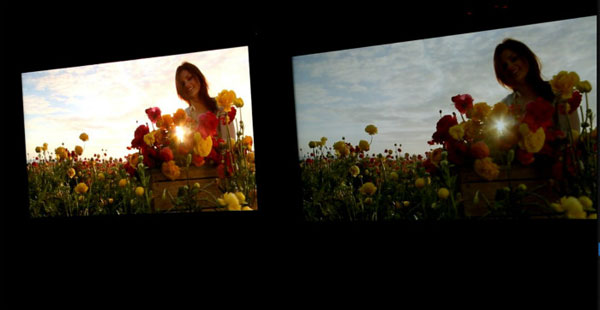 |
| From the prototype of its new imaging technology shown by Dolby Laboratories, the video product with the new technology (the left one) is brighter and clearer than the right one. (People's Daily Online/Han Shasha) |
San Francisco Dec. 5 (People’s Daily Online)--Dolby is globally recognized as an innovator of sound, video, and voice technologies, but today people may need to refresh their knowledge with its new imaging technology that possibly disrupt industry standard for the brightness of current TV images.
What is the industry standard for the brightness of current TV images? Pat Griffis, executive director of technology strategy at Dolby Laboratories introduced that it’s 100 nits. However, according to Dolby’s survey, 90% of viewers preferred a TV that went as bright as 20,000 nits.
As a measure of light emitted per unit area, nit is frequently used to specify the brightness of a display device. Here is an example in Dolby’s blog saying that a 100-watt incandescent lightbulb puts out about 18,000 nits. And most consumer desktop liquid crystal displays have 200 to 300 nits.
What Dolby has done is offering up to 4,000 nits of backlight out of an LED panel.
The difference can be known in Mike Rockwell’s blog. The executive vice president of advanced technology group at Dolby wrote in his blog that today’s TVs simply can’t match the depth and detail of a display that can produce far brighter images. And conventional TVs can’t recreate all the colors found in the world around us.
And the contrast is found when reporters stand in front of the lab’s prototype.
Pat Griffis ironically joked that the video product without the new technology is taken in London, while the other one is in California, which can be seen in the photo----the sky in the right one is grayish while the left one is bluish.
And the right one is what many filmmakers are using for viewing their footage before it goes through the process of compression. Those footages are made by the new generation of digital cinema cameras which have good dynamic range.
Pat Griffis said that although both monitors have the same resolution, the video product with the new technology offered far more realistic colors, higher dynamic range and more contrast sensitivity, which can create a fantastic viewing experience.
The new imaging technology has already been shown to key filmmakers in the industry. “We have already started the process to begin creating the standards better needed to the next generation technology,” Pat Griffis said, “But just like the standard built today, it takes time in changing the entire ecosystem that existing for 50 years.”
 Heavy cargo flights taking off
Heavy cargo flights taking off In pictures: PLA's digital equipment
In pictures: PLA's digital equipment  Americans mark Thanksgiving Day with parades
Americans mark Thanksgiving Day with parades Love searching stories in cities
Love searching stories in cities  Shanghai shrouded in heavy fog
Shanghai shrouded in heavy fog Office ladies receive ‘devil’ training in mud
Office ladies receive ‘devil’ training in mud China's first nude photographer
China's first nude photographer Selected sports photos of the week
Selected sports photos of the week Treasure of Chinese culture- Nuo Dance
Treasure of Chinese culture- Nuo Dance  Youths in Night club: photo story
Youths in Night club: photo story Models dazzle at Int'l Yacht Model Pageant
Models dazzle at Int'l Yacht Model Pageant  Crystal scenery in China: Jilin fog glaze
Crystal scenery in China: Jilin fog glaze  Tianjin holds first pole dance championship
Tianjin holds first pole dance championship  Annual Santa Claus parade held in Canada's Montreal
Annual Santa Claus parade held in Canada's Montreal China's aircraft carrier passes through Taiwan Strait
China's aircraft carrier passes through Taiwan StraitDay|Week|Month